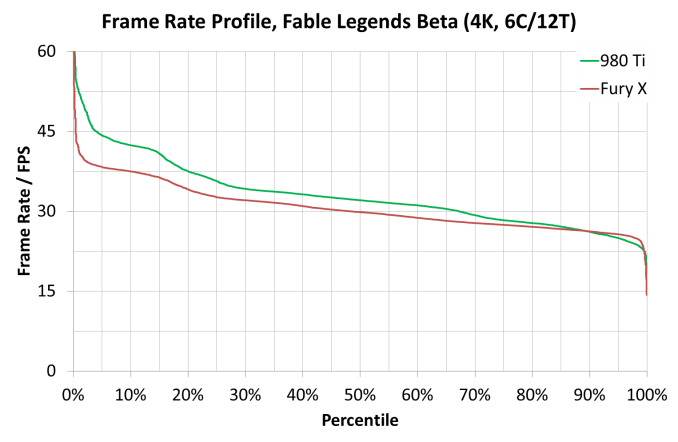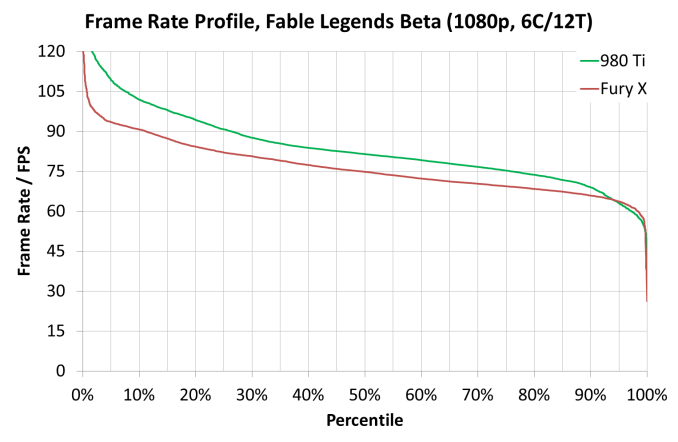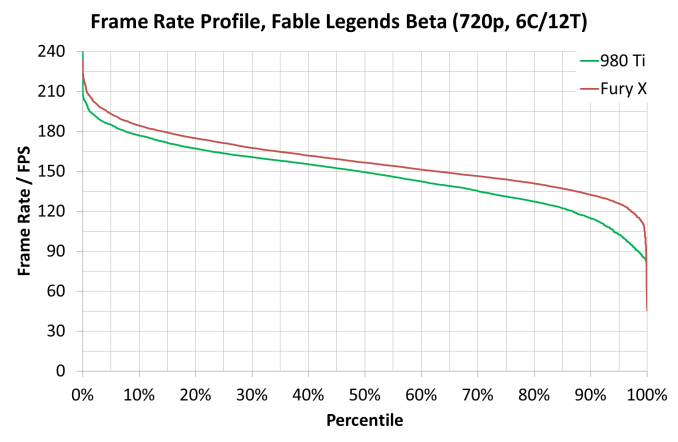Fable Legends Early Preview: DirectX 12 Benchmark Analysis
by Ryan Smith, Ian Cutress & Daniel Williams on September 24, 2015 9:00 AM ESTComparing Percentile Numbers Between the GTX 980 Ti and Fury X
As the two top end cards from both graphics silicon manufacturers were released this year, there was all a big buzz about which is best for what. Ryan’s extensive review of the Fury X put the two cards head to head on a variety of contests. For DirectX 12, the situation is a little less clear cut for a number of reasons – games are yet to mature, drivers are also still in the development stage, and both sides competing here are having to rethink their strategies when it comes to game engine integration and the benefits that might provide. Up until this point DX12 contests have either been synthetic or having some controversial issues. So for Fable Legends, we did some extra percentile based analysis for NVIDIA vs. AMD at the top end.
For this set of benchmarks we ran our 1080p Ultra test with any adaptive frame rate technology enabled and recorded the result:
For these tests, usual rules apply – GTX 980 and Fury X, in our Core i7/i5/i3 configurations at all three resolution/setting combinations (3840x2160 Ultra, 1920x1080 Ultra and 1280x720 Low). Data is given in the form of frame rate profile graphs, similar to those on the last page.
As always, Fable Legends is still in early access preview mode and these results may not be indicative of the final version, but at this point they still provide an interesting comparison.
At 3840x2160, both frame rate profiles from each card looks the same no matter the processor used (one could argue that the Fury X is mildly ahead on the i3 at low frame rates), but the 980 Ti has a consistent gap across most of the profile range.
At 1920x1080, the Core i7 model gives a healthy boost to the GTX 980 Ti in high frame rate scenarios, though this seems to be accompanied by an extended drop off region in high frame rate areas. It is also interesting that in the Core i3 mode, the Fury X results jump up and match the GTX 980 Ti almost across the entire range. This again points to some of the data we saw on the previous page – at 1080p somehow having fewer cores gave the results a boost due to lighting scenarios.
At 1280x720, as we saw in the initial GPU comparison page on average frame rates, the Fury X has the upper hand here in all system configurations. Two other obvious points are noticeable here – moving from the Core i5 to the Core i7, especially on the GTX 980 Ti, makes the easy frames go quicker and the harder frames take longer, but also when we move to the Core i3, performance across the board drops like a stone, indicating a CPU limited environment. This is despite the fact that with these cards, 1280x720 at low settings is unlikely to be used anyway.













141 Comments
View All Comments
HotBBQ - Friday, September 25, 2015 - link
Please avoid using green and red together for plots. It's nigh impossible to distinguish if you are red-green colorblind (the most common).Crunchy005 - Friday, September 25, 2015 - link
So we have a 680, 970, 980ti. Why is there a 980 missing and no 700 series cards from nvidia? The 700s were the original cards to go against things like the 7970, 290, 290x. Would be nice see whether those cards are still relevant, although the lack of them showing in benchmarks says otherwise. Also the 980 missing is a bit concerning.Daniel Williams - Friday, September 25, 2015 - link
It's mostly time constraints that limit our GPU selection. So many GPU's with not so many hours in the day. In this case Ryan got told about this benchmark just two days before leaving for the Samsung SSD global summit and just had time to bench the cards and hand the numbers to the rest of us for the writeup.It surely would be great if we had time to test everything. :-)
Oxford Guy - Friday, September 25, 2015 - link
Didn't Ashes come out first?Daniel Williams - Friday, September 25, 2015 - link
Yes but our schedule didn't work out. We will likely look at it at a later time, closer to launch.Oxford Guy - Saturday, September 26, 2015 - link
So the benchmark that favors AMD is brushed to the side but this one fits right into the schedule.This is the sort of stuff that makes people wonder about this site's neutrality.
Brett Howse - Saturday, September 26, 2015 - link
I think you are fishing a bit here. We didn't even have a chance to test Ashes because of when it came out (right at Intel's Developer Forum) so how would we even know it favored AMD? Regardless, now that Daniel is hired on hopefully this will alleviate the backlog on things like this. Unfortunately we are a very small team so we can't test everything we would like to, but that doesn't mean we don't want to test it.Oxford Guy - Sunday, September 27, 2015 - link
Ashes came out before this benchmark, right? So, how does it make sense that this one was tested first? I guess you'd know by reading the ArsTechnica article that showed up to a 70% increase in performance for the 290X over DX11 as well as much better minimum frame rates.Ananke - Friday, September 25, 2015 - link
Hmm, this review is kinda pathetic...NVidia has NO async scheduler in the GPU, the scheduler is in the driver, aka it needs CPU cycles. Then, async processors are one per compute cluster instead one per compute unit, i.e. lesser number.So, once you run a Dx12 game with all AI inside, in a heavy scene it will be CPU constrained and the GPU driver will not have enough resource to schedule, and it will drop performance significantly. Unless, you somehow manage to prioritize the GPU driver, aka have dedicated CPU thread/core for it in the game engine...which is exactly what Dx12 was supposed to avoid - higher level of virtualization. That abstract layer of Dx11 is not there anymore.
So, yeah, NVidia is great in geometry calculations, it's always been, this review confirms it again.
The_Countess - Friday, September 25, 2015 - link
often the fury X GAINS FPS as the CPU speed goes down from i7 to i5 and i3.3 FPS gained in the ultra benchmark going from the i7 to the i3, and 7 in the low benchmark between the i7 and the i5.